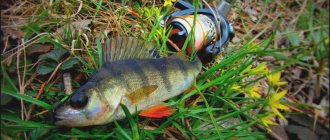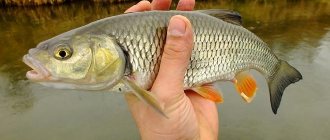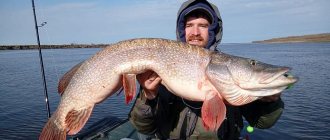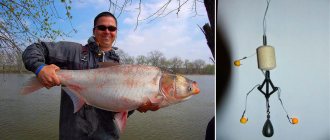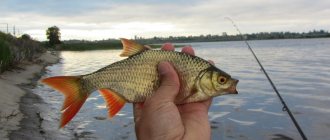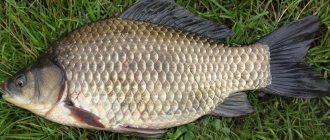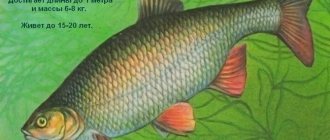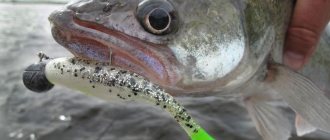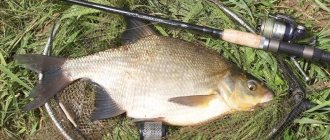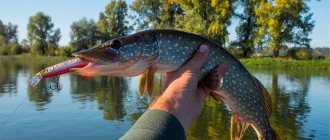In spring, you should be aware of meltwater from fields carrying worms, larvae and a lot of animal food. It is better to look at the confluence of streams and small rivers. To spawn, it goes to flooded meadows, where it mainly feeds on the eggs of other river inhabitants.
For feeding, it selects areas with slight differences in the bottom, but a generally flat bottom is its best feeding place. The maximum depth where it can be detected is no more than 5 meters. But most often schools of this river trophy can be found at depths of less than a meter. You should not stop in places where the speed of the current changes, in whirlpools; it cannot be found here.
From early spring to late autumn, it is caught above or below the riffles. Having found it in such a place, you can catch several dozen fish.
Advice! Rifles are a favorite place for catching trophies.
Podust is a bottom dweller; first of all, it should be looked for on the bottom horizons of reservoirs. Occasionally you can catch it at the junctions of fast and quiet currents. You will never find podust in places with a muddy bottom and stagnant, musty water.
Description of the species
The standard size of representatives of the genus Chondrostoma is 25-30 cm with a weight of 400-500 g. Trophy specimens reach 1.2-1.5 kg (40-45 cm). The largest podust weighs 1.8-2.0 kg with a height of over 50 cm. But such individuals are extremely rare, since they reach their maximum dimensions at the end of life, which is 10-12 years.
The fish got its name from the lower terminal mouth (old mouth), located under the elongated cartilaginous snout, like a sturgeon. Another common nickname is the black belly, due to the special dark film on the inner walls of the abdominal cavity.
The main distinctive characteristics of the appearance of the undermouth include:
- body flattened laterally in the shape of a pointed ellipse;
- yellowish-orange pectoral, pelvic and anal fins;
- medium, tightly fitting silvery scales with a rounded posterior edge (cycloid type);
- dark olive color of the back, on which a smoky-gray fin is located (3 unbranched and up to 10 branched rays);
- low head with a flat nose and large eyes;
- clearly visible lateral line of dark color;
- black rim on the tail.
The color pattern and tone depend on the genus taxon, specific habitat conditions in the river and the season: during the spawning period, all orange, yellow and red shades on the fins of males become an order of magnitude brighter.
Volzhsky Podust
Latin name: Chondrostoma variabile. Listed in the Red Book of the Saratov Region as a “vulnerable species.” It is distinguished by its more modest size (up to 1.4 kg) and shorter life expectancy (up to 8-9 years). The lower jaw has a sharp end. There are 52-62 scales in the lateral line. The dorsal fins are greenish in color. It lives in tributaries and rivers of the European part of Russia (Volga, Don, Ural), also found in the Sura, Moscow River, Oka and large reservoirs (Kuibyshev, Volgograd, Saratov).
To learn more:
Types of carp: mirror, koi and others
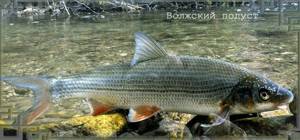
Genoese (Western European) podust
The name in Latin is Chondrostoma genei. It lives in Italy, Slovenia, Austria, Belgium, France, Switzerland and in many rivers of the Adriatic and North Seas. The fish is distinguished by its yellow-green back and colorless fins. The lateral line runs through the entire strongly elongated body, but is poorly visible. Grows up to 35-40 cm (1.2-1.4 kg).
Dneprovsky Podust
The Latin name of the fish is Chondrostoma nasus nasus natio borysthenicum Berg. It has a moderately high body and a light, scaleless keel between the anal and ventral fins, colored red. Habitats are rivers, tributaries and reservoirs that form the basin of the Black and Azov Seas. Podust is especially numerous in the Dnieper and Southern Bug. Grows up to 1.5 kg (up to 45 cm).
Fishing with a float rod
Podust are usually caught with float rods. The gear should be light, since the fisherman has to constantly transfer the equipment.
But, on the other hand, podust fish is not small. Instances of 300-400 grams are considered common, and large podust can weigh up to a kilogram. In addition, once hooked, the podust behaves quite smartly. Therefore, the main line on the fishing rod is placed with a diameter of 0.2-0.25 mm. When the line is about 0.2 mm, use a 0.15 mm leader. With a “base” of 0.25 mm, a leader of 0.17 mm is required.
Hooks for catching undermouth are usually used No. 4.5-5 according to the domestic classification.
Habitats
The common podust has a rather limited range due to its attachment to warm, clean and oxygen-rich water, moderate currents and a hard bottom, near which it spends its entire life. That is why representatives of the carp family can only be found in lowland and mixed rivers with slow sections, large flowing reservoirs and lakes. In Russia, the black belly lives in the basins of the Caspian, Baltic and Azov seas, for example in the Western Dvina, Klyazma, Oka, Kama, Volga, Don, Kuban.
A school of fish usually consists of several dozen individuals of the same age and size, choosing a flowing area with depths of 1.5-3 meters as a permanent habitat. If there is a riffle on the river, the podust sites are located immediately above it and several tens of meters below, since there is the largest amount of the main food - periphyton fouling.
Periphyton organisms (obrogetes) are dense colonies of microscopic animals and plants (diatoms, green algae, bryozoans, insect larvae, rotifers, suctoria, ciliates, etc.), which require a solid substrate and a lot of sunlight for development. These circumstances determine the shallow depth of residence of the sub-dust and its attachment to the sandy-rocky bottom of the river.
The fish remains active from early morning until late evening. Even intense heat in August and frequent bad weather in September are not able to affect the usual schedule of the flock; it feels comfortable in the bottom layers regardless of any changes in the environment. Only in the cold autumn, when the volume of periphytic fouling decreases, does the undergrowth gradually slide down to the maximum depth in the river, where it overwinters in pits, next to other representatives of the cyprinid family.
To learn more:
Amur catfish - description and characteristics of fish
Winter features
In winter almost no one goes there . Most fishermen believe that during the cold season this fish sits in pits and does not feed at all, and therefore catching podust in winter is a completely pointless activity.
However, there are other opinions that are completely opposite to the previous one. And according to these opinions, podust is excellently caught in winter.
The main reason why it is believed that it does not bite in winter is the wrong fishing location. It is still very early in the season when the fish leaves the current, and the fishermen who try to catch it there obviously cannot succeed.
You need to look for podust in quiet backwaters, not far from summer camps. And when fishing with a jig - in winter he behaves very indecisively, and any manipulation of the rod is extremely undesirable.
The next feature of winter catching undermouth is that you need to hook under any pressure. Hold the fishing rod in your hands and be alert. You'll need nerves of iron here. Firstly, sometimes it may peck continuously, but other times it won’t for a long time. Secondly, not everyone will retain enthusiasm after 10 unsuccessful hooks. But the most patient and dexterous will be rewarded.
You should not take previously steamed grains as complementary foods.
Podust at this time is not at all voracious and having received bait, he will calmly go to his hole, leaving the fisherman with nothing. Breadcrumbs are much better.
When the thaw begins, it is well caught with bloodworms.
Reproduction
Podust spawning occurs in the first half of spring, at a water temperature not lower than +8-10°C. Mature males, starting from 3-4 years of age, participate in the process of spawning. Females mature 1-2 years longer. Shallow water with a pebble or sandy bottom is chosen as a spawning ground.
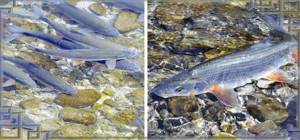
Fish spawning is one-time and occurs in the morning or evening twilight. The clutch contains from 2 to 12 thousand large whitish eggs, the incubation period of development is 10-14 days. After hatching, they intensively feed on plankton in the water column for several months. Having become a fry, the podust switches to a bottom lifestyle and begins to eat detritus, benthos, and periphyton fouling, scraping them off stones, snags, and aquatic vegetation.
Float tackle for fishing underwater
Podusta can be caught on all types of float rods: fly rod, Bolognese rod, match rod. Usually fishing is carried out on the current while fishing. If there is a dump near the shore and a hard clay or sandy bottom, then you can use a fly rod with a length of 5 to 7 meters. We set the fishing line with a thickness of 0.12-0.18 mm. We use the float with a blind fastening type with a load capacity of 2-3 grams.
We set the leash 15-20 cm long with a cross section of 0.12. It is better to use fluorocarbon, as it is more resistant to abrasion by shells and stones. Hook No. 12-20 is used. In summer they install larger ones, and in cold weather - the smallest ones.
If the fishing distance exceeds 10 meters, then it is better to fish with a Bolognese fishing rod 5-7 meters long. A float is required with a carrying capacity of 2.5 to 3.5 grams. We attach a reel with a front drag to the fishing rod with a spool capacity of 2000 to 3000. We take fishing line with a diameter of 0.18-0.2 mm. We use wires with a length of 20 to 30 cm. If you don’t have fluorocarbyne fishing line, you can take a regular one. To prevent it from twisting too much, it can be attached to the main fishing line through a small swivel:
If the fishing distance exceeds 20 meters, then it is better to use a match rod with a length of 3.6 to 3.9 meters.
A reel with a spool volume of 3000 to 4000 with a fishing line with a cross section of 0.2 -0.22 mm is placed on it. The float is attached sliding with a load capacity of up to 4 grams of this type:
All types of fishing rods are equipped with shot weights of 5-6 pieces or one sliding one in the form of an olive, which runs between two shotguns or stoppers.
Follow us on social networks
— through them we publish a lot of interesting information, photos and videos.
Popular sections of the site:
The fisherman's calendar will allow you to understand how all the fish bite depending on the time of year and month.
The fishing gear page will tell you about many popular gear and devices for fishing.
Fishing baits - we describe in detail live, plant, artificial and unusual ones.
In the bait article you will get acquainted with the main types, as well as tactics for using them.
Learn all the fishing lures to become a real fisherman and learn how to choose the right one.
Fishing locations and biting times
Maximum food activity occurs in the morning and evening. During the day, the fish becomes calmer and more cautious, although it continues to feed.
When choosing a place for fishing underwater, you must immediately exclude sections of the river with a muddy bottom, too slow a flow and blooming water. The rapid proliferation of phytoplankton, which turns everything green, is a clear indicator of stagnant water with oxygen deficiency.
Promising places for catching podust are shallow riffles, sandy, pebble edges on the border of a fast current, shallow water near a steep bank, areas with stone ridges and piles of snags. Blackbelly often lives in close proximity to artificial structures installed in the water and bridge piles, where huge colonies of periphyton organisms live.
Fishing for undermouth in the fall
With the onset of cold weather , the podust goes into the pits, and there is no point in catching it according to the previous scheme.
On good and warm days, catching underwater in the fall is no different from summer fishing. Some fishermen believe that it is better caught with bloodworms and dung beetles.
Are you interested in fishing with a mandula? Our article will tell you and show you more about this.
This article will show the basic techniques for catching asp using spinning baits.
How and what to catch podust
Almost all methods of fishing for bottom fish in the current are suitable, but fishing with a float rod using the retrieving method is considered the most interesting and effective.
Despite its modest size, the podust is distinguished by great strength and endurance, so the equipment should be light, but withstand powerful jerks.
The optimal gear parameters look like this:
- a rod with a fast action, 3.0-3.5 meters long;
- inertial coil;
- main line – 0.22-0.25 mm (with breaking load from 3 kg);
- leashes – 0.16-0.2 mm;
- hooks with a short shank No. 10-5 (international numbering) or No. 5-8 (standardization of the Russian Federation).
To learn more:
Tench: description of fish, habitats, spawning and fishing methods
Due to constant feeding at shallow depths, the blackbelly is quite bold and comes close to fishermen's boats. But noises from the shore alarm him; here it is better to use long-range gear.
Fishing on a feeder
Rods with a length of 3.5-3.9 m with a medium-fast action and a cast of up to 120 g are used. For long casts from 40-45 m, a braided cord of 0.12-0.15 mm is wound on a spinning reel with a spool capacity of 3000-4000. For fishing at a distance of up to 40 meters, you can use 0.22-0.25 mm monofilament.
For fishing undermouth in the spring and from September to October, it is wise to use an asymmetrical loop. It provides better visualization of the bite and free movement of the feeder at a distance of 30-60 cm, which allows cautious fish to swallow the bait deeper without any resistance from the gear. Fishing for subdust in June, July and August does not require complex equipment; either a symmetrical loop or any other feeder installation will do. In addition, you can use classic donks without a feeder.
Spinning fishing
Despite its herbivorous nature, podust responds well to artificial moving baits, especially in the fall. Small spoons, spinners, wobblers and silicone baits designed for catching chub, ide, asp are suitable - Blue Fox Super Vibrax, Forest Crystal, Strike Pro, BJ-Bug. In this case, the spinning retrieve must be slow enough so that the fish has time to grab it with its low mouth.
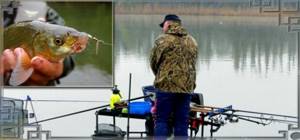
Feeder equipment for fishing underwater
Podust are caught in sections of rivers with small and medium currents. If we are talking about feeder fishing, we mean medium rods with a test weight of up to 100 grams and heavy rods with a test weight of up to 120-150 grams and a length of 3.6-3.9 m. Depending on the strength of the current, the weight of the feeder is selected, and therefore the type of rod . You should also consider the volume of the feeder and the weight of the feed.
It’s better to check the weight of feeders with food on electronic scales at home in order to understand how much heavier the feeders with bait become. It is clear that mixtures come in different densities and can be filled in different ways. Take measurements with different packing densities of feeders.
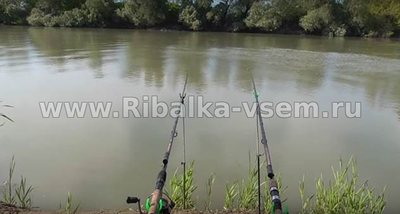
On the feeder rod we place a reel with a well-functioning friction brake. It is not necessary for the reel to have an instant reverse stop. This is more necessary for spinning models. In our case, it doesn’t matter where the clutch is located, the main thing is that it is easy to adjust and the line moves evenly under different loads. The spool capacity can be from 3000 to 5000.
Is it better to use fishing line or braided cord on the feeder? It makes no difference if you fish at a distance of up to 35 meters. If the distance is greater, then use a braided line. It will allow you to see the most sluggish bites. Wattle is very popular in early spring and late autumn. If you fish with a fishing line during these periods, you may not see a single bite. Not only will you be able to spot them on the fence, but you will also catch fish.

Since podusta are often caught on rocky bottoms, a shock leader may be required. This is a 5-8 meter long piece of fishing line or wattle with a cross section of 0.4-0.8 mm, which makes the tackle more durable. Thanks to the shock leader, the tension on the main line when casting is reduced, and it will not rub so intensely against a stone or shell. It is up to the angler himself to decide whether to use a shock leader or not. This is an optional feeder accessory. If you don't like it, you can do without it.
The best feeder installation for fishing underwater in the middle reaches will be an asymmetrical loop. This is perhaps the most sensitive editing. Regardless of which side the fish bites from, even the slightest touch of it to the nozzle will be reflected on the tip. In tandem with the braided line, the asymmetrical pattern is the best indicator of bites when fishing in the current.
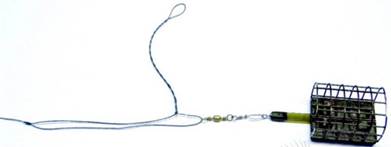
The asymmetrical loop is a removable installation that makes it easy to change feeders. At the end of the loop there is a fastener that is threaded through the loop of the main fishing line. A swivel with a carabiner is threaded onto the large mounting loop to secure the feeder. The leash is attached to the twist loop. It is better to start with a leash 50 cm long and 0.16 mm thick in summer and 0.1-0.12 in autumn and spring. If you don’t see any bites, then shorten it, and if there are none, then lengthen the leash.
The simpler paternoster feeder installation is best used when fishing in calmer areas. It can be removable, or it can be knitted on the main fishing line.
Recently, flat-method sliding rigs are increasingly used when fishing with a feeder. They are very well suited for fishing in still waters and in areas with little current. Method installation looks like this:
The point of the method is that the hook with the nozzle is located close to the feeder. Often foam is placed on the hook. The expectation is that the fish will eat food from the feeder and swallow the bait. The methods work well in summer and in warm autumn and spring.
The inline rig is also well suited for subdust fishing. It is removable and allows you to quickly change the feeder and leash. When forming it, you should select rubber stoppers that would slide tightly along the fishing line and withstand the pressure of feeders weighing up to 100 grams.
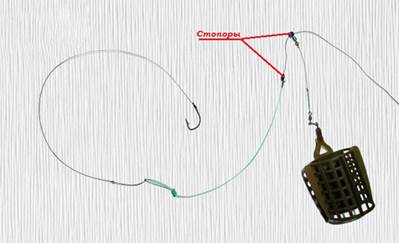
Some fishermen also use a tube with an anti-twist. This installation is not as sensitive as the previous ones. It is designed for fishing with good activity of the undermouth, and also allows you to easily change feeders. Use a shorter tube:
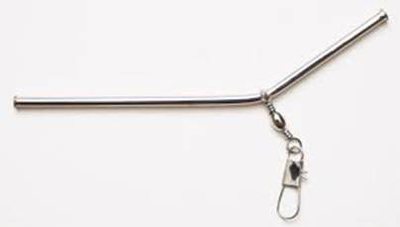
It is better to install the rod on a stand:
Baits and lures
The black belly has an excellent appetite; it readily eats animal and plant foods. The following can be used as a catch bait for the undermouth:
- dough, bread crumb, boiled peas;
- steamed grains, pearl barley, snail meat;
- mastyrka, bloodworms, maggots;
- earthworm and dungworm;
- honeydew, bark beetle larva, bunch of filamentous algae;
- caddisfly, a piece of crawling, large ant eggs.
It is not recommended to use hooks with a long shank for fishing, since then the fish cannot completely swallow the bait. At the moment of hooking, the sting of the hook simply slides off the hard lips of the undermouth or pierces only their edge, which is not enough for successful fishing.
To learn more:
Description of the chub - a large fish of the carp family
What to feed?
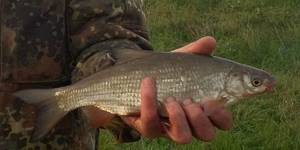
An experienced fisherman will agree that without bait, fishing for podust is doomed. But you shouldn’t over-feed it either - the fish quickly gets full and loses interest in the bait. Therefore, in order to successfully fish, you need to be able to find the golden mean.
The following can be used as bait:
- bread crumbs;
- cake;
- steamed bran;
- finely chopped worm;
- ant eggs,
- maggot;
- bloodworm.
It is better to immerse maggots and bloodworms in water in a small canvas bag. Then it will attract fish for a long time, but at the same time will not overfeed it. The cake is thrown into the water in pieces (if there is no strong current), and worms, ant eggs and bread crumbs can be mixed with the soil, formed into small balls and thrown into the water exactly in the place where you are going to fish.
It is advisable to start feeding the bait 20-40 minutes before the start of fishing, so that fish accumulate in the right place.
The importance of groundbait
The result of catching undermouth directly depends on the fisherman’s ability to form a stable cloud of food turbidity, as well as a fragrant trail spread by the river current. There is no need for culinary delights - the fish reacts to flour, crackers, bran, boiled peas, millet, crushed biscuits, cereals, and barley. One of the most attractive baits is buckwheat with the addition of garlic, coriander, and vanilla flavor enhancers.
Store-bought baits are widely used for other representatives of the carp family, for example, FISH DREAM “Universal”, DUNAEV “Feeder”. Crucian carp", "Volzhanka. Roach", GF "Feeder. Bream".

Before fishing, you need to feed the bait in advance or immediately after arriving at the reservoir. If the weather is cool, it is advisable to add additional ingredients of animal origin: chopped worms, bloodworms, maggots. In order not to scare away the fish, it is advisable to give the mixture a sandy-clay tint. You can use cinnamon or turmeric for this.
Popular mixtures for podust
Let's consider several options for baits for fishing underwater. For example, we need to prepare bait for float or bottom fishing. We know that the current at the fishing spot is not very strong. In this case, we will use the following composition:
- Breadcrumbs – 0.5 kg
- Steamed Hercules – 300 gr.
- Pearl barley – 300 gr.
- Bait "Bream + roach" - 0.5 kg
- Molasses – 300 gr.
- Liquid vanilla liquid
We cook the cereals at home and put them in bags. On the shore we mix the composition and evaluate the consistency. We need the bait to quickly separate from the feeder and create a bright spot on the bottom.
If we see that the mixture is very crumbly, then add a little clay. If we have a very heavy bait that works slowly, we can add baking soda to it. It will cause the bait to quickly crumble. You should have some baking soda in stock. It can be used to easily loosen very viscous mixtures.
For fishing in areas with stronger currents, more viscous baits are used. Here is one of the bait options:
- Boiled wheat – 0.5 kg
- Makuha – 0.5 kg
- Clay – 0.3 kg
- Hemp oil – 30 gr.
- Coriander – 40 gr.
- Feeder bait for the river – 1 kg
- Molasses – 0.5 l
We moisten the bait in two stages. Sift the dry mixtures through a 3 mm sieve. Pour undiluted molasses into a container and mix with flour and groundbait. Next, add the remaining ingredients and mix everything well again. We check near the shore how long it takes for the food to be washed away under the influence of the current. If the density is satisfactory, we proceed to starting feeding. If not, then add more clay or vice versa - dry ingredients.
Hooking and landing
Podust is caught well from late spring to October, showing various types of bite. He can suck on the pearl barley for a long time and then smoothly lay out the float, sharply grab the worm and instantly drag the entire tackle under water. But no matter how the float antenna or the tip of the rod behaves, at the right moment it is necessary to perform a sharp and strong hook in order to reliably drive the hook into the hard lips of the fish.
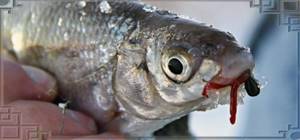
During fishing, the undermouth actively resists, demonstrating a strength that is surprising for such small dimensions, which makes fishing interesting and tempting. Since this fish is often caught in places rich in snags and aquatic vegetation, it is important to constantly monitor the tension of the fishing line and not allow the trophy to hide in cover. In order not to be left without a catch at the last moment, you need to use a landing net.
Fishing for podfish in summer
At the beginning of summer, after spawning, the podust immediately rolls down to the lower reaches, and it is very difficult to catch it. A good catch can only be obtained when all the vegetation is in bloom. Most podusts feed near pebbly and rocky places. The reason is that the stones are overgrown with algae, which is the main food of this small fish.
But fishing here is not fruitful. Due to the stones and the crevices they form, fishing is accompanied by constant snags, and the bait is ineffective. And bait is very important when fishing for bait.
Podust is best caught near clay steep yars . You need to look for places where you can reach the bottom, since this is where the underdust floats. It’s good if the bottom is without unevenness. Then there will be no snags.
If you can’t find the most suitable place or don’t want to, you need to fish with a plug or half-bottom. A feeder is also suitable if the fisherman has sophisticated technique.
He is constantly in search of food. Therefore, and also because of the variable current, it moves all the time. Since algae grows very quickly, fish visit their site every day. And this happens during the daytime.
We can conclude that the ideal position of the fisherman is upstream from the school of feeding pods. This way the fish will swim straight into the net.
This article will teach you how to make a mandula for pike perch with your own hands.
And here you will see trophies and records of December IGFA fishing.
Taste qualities of the podust
Blackbelly fish taken from natural conditions quickly die and deteriorate, so it is important to use a long cage and process the fish immediately.
In terms of consumer characteristics, nutritional value and culinary versatility, podust is inferior to carp, ide, bream and is quite bony. To prepare aromatic dishes, frying, baking in foil, hot and cold smoking are used. Due to its moderate calorie content (104 kcal per 100 g) and low fat content (4.3%), podust is well suited for dietary nutrition.
